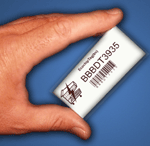Dec 30, 2003Trolley Scan, an RFID design and development company based in Johannesburg, South Africa, has developed a UHF RFID passive transponder that uses just 250 microwatts (a microwatt is equal to one millionth of a watt) of energy to operate. Lower power consumption means the RFID tags can typically operate at longer distances with greater reliability.
One problem with using RFID at ultra-high frequencies—typically 868 to 956 MHz—is that it's difficult to transfer the energy in the radio wave efficiently from the air to the electronic circuit due to incompatibilities between the electronic chip and the antenna.
Trolley Scan has been awarded United States patents for technology that improves the transfer of energy from the antenna and the microchip in the RFID transponder. In technical terms, the improve performance comes from calculating and implementing the correct transfer network to match the "antenna impedance to the equivalent load of the transponder circuit as seen via the power rectification circuits of the transponder," according to the patent.
"We are dealing with the correct antenna-chip interaction, and that's where we get phenomenal improvement in performance," says Mike Marsh, Trolley Scan's managing director.
Trolley Scan's new EcoTag incorporates the technology. The transponder is smaller than a credit card and needs just 250 microwatts of radio energy to operate—one quarter of the energy needed by the previous version of the EcoTag, which was considered energy efficient compared to some other UHF tags on the market.
In addition, the antenna of the new EcoTag is half the size of the antennas generally used on other UHF transponders. What’s more, the EcoTag antenna can be produced using simple manufacturing processes, such as printing directly onto the packaging with a printing machine using conductive ink.
"The transponder antenna has a area to collect energy from the reader called the aperture," Marsh explains. "For a dipole antenna on a 915 MHz transponder, the aperture is 134 square centimeters. When 250 microwatts of RF power pass through that aperture—or the transponder is in an energy field of 18 milliwatts per square meter—the transponder will receive enough power to operate fully and communicate all its data."
The antenna typically found on most other UHF transponders is 160 mm long (6.3 inches). Cutting the antenna size in half to make it fit within an ordinary bar code label results in the antenna being able to capture only 3 percent of the energy of the longer antenna. That reduces the read range dramatically, which offsets the key advantage of using UHF.
Trolley Scan has developed an 80 mm by 33 mm flat antenna that is far more efficient than most UHF antennas at that size. The transponder can operate at ranges as far as 28 feet (9 meters). The design is also ideal for producing transponders with antennas that use conductive inks applied with a printing press. That's because the antenna is in a flat plane, rather than three-dimensional. Printed antennas are cheaper and easier to produce than the etched, solid metal antennas, and they don't interfere with the recycling of packaging.
Trolley Scan has commenced commercial production of the new EcoTag. It sells a small pilot system consisting of a reader, 100 transponders, antennas, cables, and software for 1,700 euros (about US$2,100). Additional readers and transponders are available to expand the initial system.
The EcoTag uses a proprietary protocol. However, Trolley Scan also licenses its patents and technology to manufacturers around the world, and the new energy-efficient technology can be applied to any UHF tag using any protocol.


